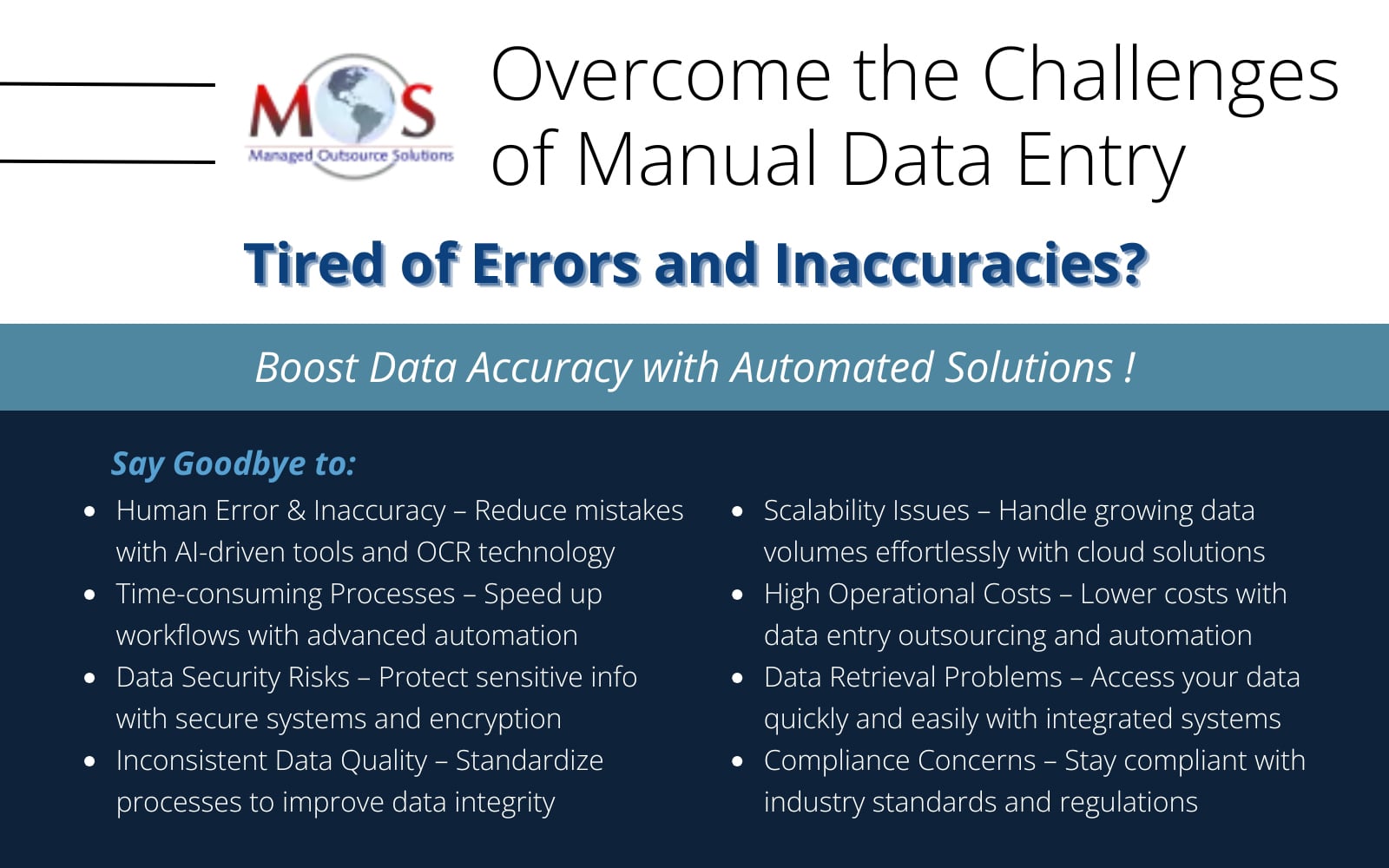Data is the essence of any business as it is used to make critical decisions. This is why it’s important to capture data accurately. Manual data entry involves inputting information into a computer or system by hand, typically through typing or other manual methods. Despite several advancements in automation, manual data entry remains essential in various industries, especially where complex or sensitive data requires careful handling and verification. Inbound documents, whether feedback forms, catalogs, purchase orders, invoices, or any other type, need to be accurately captured. Manual data entry continues to be a crucial aspect of business operations in 2025, but it presents several challenges that impact productivity and accuracy. As businesses generate vast amounts of data on a day-to-day basis, relying on outdated data entry methods can lead to inefficiencies. This blog will discuss manual data entry challenges businesses face in 2025 and how data entry outsourcing services can help overcome them.
Key Manual Data Entry Challenges and How to Avoid Them
Typically, manual data entry is the process of inputting information into a computer or database system by hand, usually with a keyboard or other input device. This method involves human operators transcribing data from various data sources, such as paper documents, forms, or digital files, into electronic formats. Manual data entry is highly labor-intensive and prone to errors, making it less efficient compared to automated data entry solutions. According to reports, on an average, manual data entry tasks may have an error rate of about 1%, with specific contexts like research and medical settings experiencing error rates ranging from 0.04% to 3.6%. When it comes to the quality of output, speed, accuracy, and other factors, manual data entry comes with several unique challenges such as –
- Human Error and Inaccuracy: One of the biggest issues with manual data entry is the risk of human errors. In manual data entry, businesses have to deal with frequent human errors, leading to inaccuracies in records and reports. Mistakes such as typos, duplicate entries, misinterpretations of handwritten data, or lapses in attention during data input and incorrect formatting can compromise data integrity, leading to poor decision making and financial losses. Data entry services leverage automated tools and trained professionals to ensure accuracy and consistency. In the year 2025, advancements in technologies like Optical Character Recognition (OCR) and AI-driven data validation will significantly reduce error rates, enhancing data accuracy and efficiency. Businesses will increasingly use these tools to streamline operations, and mitigate risks associated with manual entry. This ensures reliable decision making based on pristine data integrity.
- Time-consuming: Manual data entry is slow and requires significant effort, making it difficult to keep up with growing business demands. Employees spend valuable time entering data from various sources into systems instead of focusing on strategic tasks. This leads to errors that can further delay processes. By opting for data entry outsourcing services, businesses can speed up the process while maintaining accuracy. As data volume grows, this challenge becomes increasingly cumbersome, requiring more resources and time for accuracy checks and corrections. However, in 2024, several organizations took steps to overcome this challenge by embracing advanced software systems. Advancements in automation, AI technologies, and machine learning are set to revolutionize data entry processes in 2025. Businesses will adopt smart data capture solutions that leverage OCR and natural language processing (NLP) to automate extraction and entry tasks. This radical shift results in significant time savings and enhanced accuracy through reduced human intervention thereby improving overall productivity.
- Data Security Risks: Handling sensitive data manually increases the risk of breaches and data loss. Without proper security measures, businesses may expose confidential information to unauthorized access. Data entry outsourcing services provide secure systems, encryption, and compliance with industry regulations to ensure data protection.
- Inconsistent Data Quality: Inconsistent data quality is significant manual data entry challenge. Human error, varying data formats from different sources, and lack of standardized procedures often result in inaccuracies and inconsistent quality in the entered data. Such low-quality data can lead to flawed analytics, decision-making, and operational inefficiencies. In 2025, businesses are combating this issue by implementing AI-driven algorithms to detect and rectify inconsistencies in real time. This will improve data quality and integrity across systems. Additionally, the adoption of standardized data entry protocols and training programs will enhance employees’ data handling skills, reducing the occurrence of errors at the source.
- Lack of Scalability: As businesses grow, so does the volume of data. Scaling manual data entry operations to match increasing demand is difficult and inefficient. As businesses grow and data volumes increase, the demand for additional manpower or data entry personnel to handle data entry grows proportionately. Scaling operations traditionally involve hiring and training additional staff, which can be costly and time-consuming. In 2025, the scalability of data entry processes is set to evolve with the adoption of automated solutions. Technologies such as cloud computing, scalable database architectures, and AI-driven data processing will enable businesses to handle large volumes of data more efficiently. Automated data entry systems can dynamically adjust to fluctuating workloads, ensuring consistent performance and scalability without the need for extensive human intervention. Data entry services offer flexible solutions, allowing businesses to scale up or down based on their needs without additional overhead costs.
- Higher Operational Costs: Maintaining an in-house data entry team requires investment in salaries, training, and technology. The risk of errors inherent in manual processes necessitates additional resources for error detection, correction, and reprocessing, all of which escalate costs. Moreover, the time-intensive nature of manual data entry prolongs project timelines and reduces overall operational efficiency. This makes manual data entry an expensive operation. Outsourcing data entry helps businesses reduce overhead expenses while gaining access to skilled professionals. In 2025, businesses are expected to transition towards robotic process automation (RPA) and intelligent data capture systems. This will help streamline data entry tasks, reducing labor costs and minimizing error rates.
- Difficulty in Data Retrieval: Manual data entry often leads to difficulty in data retrieval. Retrieving specific data points from voluminous and potentially disorganized manual records can be a major challenge. Employees may struggle to locate and extract relevant data quickly. This may hamper responsiveness to customer inquiries, regulatory requests, or internal reporting needs. In 2025, businesses will increasingly adopt integrated database systems and cloud-based storage solutions that facilitate faster and more efficient data access.
- Compliance and Regulatory Issues: Businesses must comply with industry regulations regarding data management and privacy. Manual data entry processes often lack proper audit trails and documentation, leading to compliance risks. Data entry outsourcing services follow strict regulatory standards, ensuring compliance with data protection laws.
- Integration Challenges: Modern businesses rely on multiple software applications, but manual data entry makes integration between systems challenging. Errors and inefficiencies arise when data is transferred between platforms manually. Data entry services use automation tools to ensure seamless integration across different systems.
Say goodbye to manual errors with professional data entry services.
Get in touch with us for a customized solution tailored to your business needs!
As automation tools and AI-driven technologies continue to advance in 2025, manual data entry is expected to decline significantly. However, it is still important in certain industries and areas. Businesses will depend on advanced verification and validation systems to streamline manual data entry processes. As a result, manual data entry tasks will become more specialized, focusing on exception handling and verification rather than routine data input.
As any small error can have a huge impact on data, several organizations depend on third-party service providers for manual data entry tasks to avoid related challenges. Outsourcing manual data entry tasks to professional providers helps businesses leverage expert services to enhance accuracy, speed, and consistency. This reduces operational costs, frees up internal human resources, and allows companies to focus on their core competencies.





